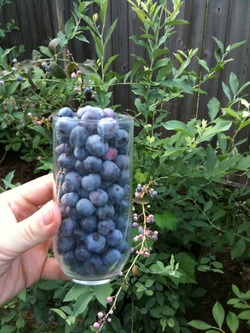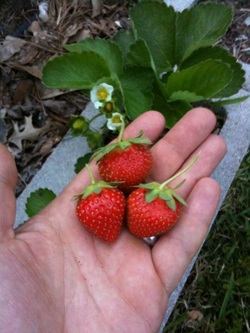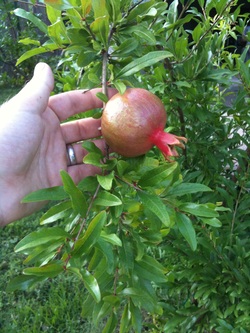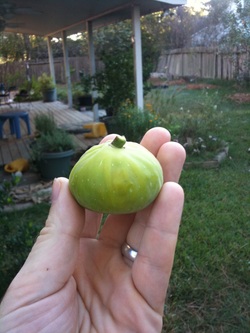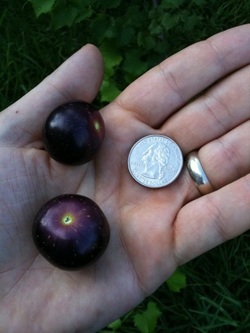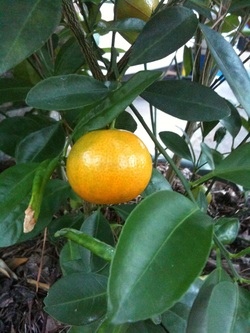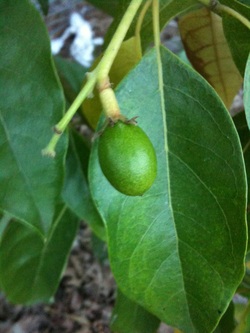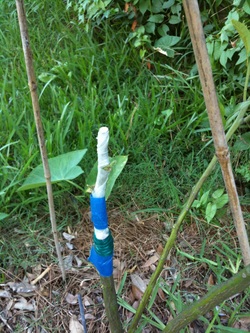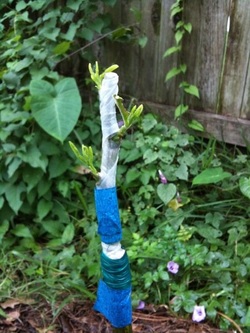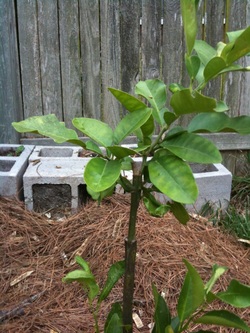My Backyard Orchard
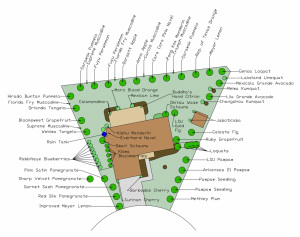
February 2011 Map. Click to enlarge.
If I could, I would tear out every last blade of grass and only have fruit trees and vegetable beds. However, in order to stay happily married, I have to limit my fruit tree madness to the borders of the yard and leave some open space so the children have a place to play, etc. It is my mission to grow as as much fruit as possible on my 0.2-acre suburban lot, so that my kids can go outside and pick a snack year-round. I have planted somewhere around 50 fruiting trees and bushes representing approximately 100 cultivars, with fruits ranging from the common to the unusual. It will probably take 5 years or so to bring everything into full production, but it will be worth the wait. As I go, I'm going to try to develop a fruit calendar specifically for my area in northwest Houston, and keep detailed notes on which varieties perform the best.
What I was growing as of February 2012:
|
Apples
Anna Dorsett Golden Cinnamon Spice Ein Sheimer Chenango Strawberry Honeycrisp King of Tompkins County Calville d'Hiver Mutsu Granny Smith Pomegranates
Kashmir Blend Unknown (Red Silk?) Garnet Sash Desertyni Kandahar Early Pink Satin Sharp Velvet Eve Other
Cherry of the Rio Grande Grumichama 4 Mangos Hana Fuyu Persimmon Genoa Loquat Seedling Pakistan Mulberry Miracle Fruit Coolidge Pineapple Guava Unknown Pineapple Guava |
Figs
Celeste LSU Gold LSU Purple South Carolina Lemon Petite Negra BA-1 Alma Osborne Prolific Black Jack Green Ischia Texas Blue Giant Mr. Smith's Unknown Avocados
Brazos Belle Poncho Fantastic Cherries
Minnie Royal Royal Lee Muscadines
Darlene Supreme Florida Fry Jujubes
Honey Jar Sugar Cane Unknown (Powers?) |
Berries
Kiowa Blackberries Sweet Charlie Strawberries Premier Blueberries Brightwell Blueberries Tiftblue Blueberries Woodard Blueberries Climax Blueberries Southern Highbush Pears
Southern King Southern Queen Acres Home Tennhosui Tennessee Meadows Southern Bartlett Plums
Santa Rosa Methley Peaches
Mid Pride Florida King Tropic Snow Tropic Sweet |
Citrus
Calamondin Variegated Calamondin Meyer Lemon Owari Satsuma Sarawak Pummelo Chandler Pummelo Changshou Kumquat Orlando Tangelo Bloomsweet Grapefruit Minneola Tangelo Wekiwa Tangelo Seedless Kishu Mandarin Tarocco Blood Orange Moro Blood Orange Ruby Blood Orange Everhard Navel Hirado Buntan Pummelo Cara Cara Red Navel Pong Koa Mandarin Rep. of Texas Orange Pixie Mandarin Kinnow Mandarin Fairchild Mandarin Dobashi Beni Satsuma Okitsu Wase Satsuma Ruby Grapefruit Meiwa Kumquat Valentine Pummelo Hybrid Clementine de Nules Miho Satsuma Ujukitsu Lakeland Limequat Trifoliate Orange Flying Dragon Henderson Grapefruit Golden Grapefruit |
|
My Wish List:
Nazemetz & Mammoth Pineapple Guavas Nagami Kumquat Marumi Kumquat |
Ichi-ki-kei-jiro Persimmon Budwood Sugura Persimmon Budwood Any varieties I don't already have. |
Poncirus Trifoliata
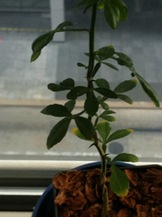
Closeup of Flying Dragon
If you're going to grow citrus in northwest Houston, it is very important to only buy trees grafted to trifoliate rootstock (Poncirus trifoliata). Though not a true citrus itself, trifoliate is closely related, and is graft-compatible with almost all citrus. It is the only 'citrus' that loses its leaves in the winter, and gives a good bit of cold hardiness to whatever scion is grafted onto it. It also produces a semi-dwarf tree, which is easier to protect from freezing temperatures, and keeps fruit at an easy-to-pick height. It can easily be recognized because as its name suggests, it has leaves in groups of three.There's also a variant called 'Flying Dragon' that is more dwarfing and has curved thorns.
Most nurseries don't label or don't know what rootstock is used, so it can be difficult to get the right thing. Both the Arbor Gate and RCW Nursery carry good selections of citrus trees grafted on trifoliate and Flying Dragon rootstock. RCW can show you what it looks like if you're interested. Check the tags and see where the tree was produced. Treesearch Farms grafts onto trifoliate. I was told at one point that Brazos Citrus Nursery grafted their stock onto trifoliate, but now it seems as though they graft citrus labeled "Dwarf" onto flying dragon, kumquats onto Volkamer lemon rootstock, and other citrus onto Carrizo citrange (orange-trifoliate hybrid). Saxon Becnel & Sons trees are grafted onto Carrizo citrange. Other good source of citrus trees on the right rootstock include Mr. Texas in Beaumont, and John Panzarella in Lake Jackson.Mr. Texas t-buds citrus on flying dragon rootstock, and Mr. Panzarella cleft grafts his onto wild poncirus trifoliata rootstock. Both will sell you rootstocks if you want to learn to graft yourself, and they will have citrus varieties you won't be able to find in most nurseries. You can see wild trifoliate and collect fruit and seeds in the fall at the Armand Bayou Nature Center.
Most nurseries like sour orange rootstock because it is cheaper, and it grows faster, and therefore looks bigger and nicer to the uniformed buyer. Most of these trees are shipped up from the Rio Grande valley, and they can have a hard time coping with our arctic cold snaps and gumbo clay soils. Don't buy trees from Walmart, Home Depot, Lowe's, or Houston Garden Center if you want them to survive long enough to produce fruit. The primary objective of the big box stores is to sell sell sell, they're not interested in the long term health of your trees. It is much better to find a good knowledgeable, local nursery. You really do get what you pay for, and it's definitely worth the extra $10 to get the best trees produced specifically for our area.
Most nurseries don't label or don't know what rootstock is used, so it can be difficult to get the right thing. Both the Arbor Gate and RCW Nursery carry good selections of citrus trees grafted on trifoliate and Flying Dragon rootstock. RCW can show you what it looks like if you're interested. Check the tags and see where the tree was produced. Treesearch Farms grafts onto trifoliate. I was told at one point that Brazos Citrus Nursery grafted their stock onto trifoliate, but now it seems as though they graft citrus labeled "Dwarf" onto flying dragon, kumquats onto Volkamer lemon rootstock, and other citrus onto Carrizo citrange (orange-trifoliate hybrid). Saxon Becnel & Sons trees are grafted onto Carrizo citrange. Other good source of citrus trees on the right rootstock include Mr. Texas in Beaumont, and John Panzarella in Lake Jackson.Mr. Texas t-buds citrus on flying dragon rootstock, and Mr. Panzarella cleft grafts his onto wild poncirus trifoliata rootstock. Both will sell you rootstocks if you want to learn to graft yourself, and they will have citrus varieties you won't be able to find in most nurseries. You can see wild trifoliate and collect fruit and seeds in the fall at the Armand Bayou Nature Center.
Most nurseries like sour orange rootstock because it is cheaper, and it grows faster, and therefore looks bigger and nicer to the uniformed buyer. Most of these trees are shipped up from the Rio Grande valley, and they can have a hard time coping with our arctic cold snaps and gumbo clay soils. Don't buy trees from Walmart, Home Depot, Lowe's, or Houston Garden Center if you want them to survive long enough to produce fruit. The primary objective of the big box stores is to sell sell sell, they're not interested in the long term health of your trees. It is much better to find a good knowledgeable, local nursery. You really do get what you pay for, and it's definitely worth the extra $10 to get the best trees produced specifically for our area.
Grafting
Most people think that grafting as a difficult and mysterious craft, not attainable by the average person. Wrong. Grafting is easily learned, and like everything else worth doing, all it takes is practice. When you're learning like I am, some of your grafts will fail, but don't get discouraged. Just try again, and every time you try you'll get better. My hope is to eventually graft several varieties onto my trees in order to get lots of different cultivars of fruits over an extended season.
I prefer the cleft graft, because you don't have to wait until the bark is slipping like you do with t-budding and bark inlay grafting. I've tried t-budding a few times with limited success, but so far I have had nearly 100% success with cleft grafting. I've even had good success with cleft grafting in the middle of the hottest driest Houston summer on record. A&M's instructional guidance on cleft grafting can be found here, and guidance on t-budding can be found here. I've also recently learned bark grafting, which is very useful when you're trying to graft a small budstick on to a large branch. A great photo tutorial by Joe Real can be found here.
I prefer the cleft graft, because you don't have to wait until the bark is slipping like you do with t-budding and bark inlay grafting. I've tried t-budding a few times with limited success, but so far I have had nearly 100% success with cleft grafting. I've even had good success with cleft grafting in the middle of the hottest driest Houston summer on record. A&M's instructional guidance on cleft grafting can be found here, and guidance on t-budding can be found here. I've also recently learned bark grafting, which is very useful when you're trying to graft a small budstick on to a large branch. A great photo tutorial by Joe Real can be found here.
Citrus Breeding
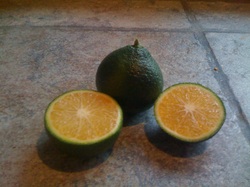
Okitsu Wase Satsuma
I think it would be really fun to breed my own variety of citrus (and name it after Dr. Wife). I first started thinking about it when John Panzarella told me about his attempt to breed a pink
lemonade fruit by crossing an Ujukitsu with a Ruby Red grapefruit. It
didn't work out for him, but it got me thinking. I wondered if I could
breed a red kumquat by crossing a Changshou kumquat with a Moro blood
orange. It turns out that's not possible either, but I still want to breed my own variety. My general plan is to attempt
one cross every year, and see what I get. I'm not sure what my first attempt will be, but being
married to a geneticist, I'm sure we'll come up with something interesting. Email me if you have an idea for an interesting hybrid.
DatePlanted December 2011
Planted January 2012 Planted November 2012 Pollinated March 24, 2013 |
Seed ParentUjukitsu
Changsha Hybrid Sarawak/Hirado Buntan Ujukitsu |
Pollen Source??? - Open Pollinated
??? - Open Pollinated ??? - Open Pollinated Wekiwa Tangelo |
Results So Far5 Seedlings
6 Seedlings Many Seedlings ---- |
Monoembryonic vs. Polyembryonic
Most citrus is polyembryonic and produces nucellar seed,
which means most of the time the seeds come true, and you
get a clone of the mother tree. This complicates efforts to create hybrids by severely limiting sexual propagation. Ideally, you want the mother plant
to be monoembryonic and produce zygotic seeds, meaning the seed will
be a sexually produced hybrid of the two parent plants. I did a little
research, and came up with a short list of monoembryonic varieties can be used
as seed parents:
|
Monoembryonic/Zygotic
Meyer Lemon Nagami Kumquat Marumi Kumquat Pummelos Temple Tangor Clementine Mandarin Ujukitsu |
Polyembryonic/Nucellar
Most Oranges Changshou Kumquat Meiwa Kumquat (mostly polyembryonic) Most Satsumas and Tangerines Most Limes Grapefruits Tangelos Poncirus Trifoliata |
Common & Uncommon Citrus Terms
|
Cicitrange = Trifoliate x Citrange
Citemple = Trifoliate x Temple Tangor Citradia = Trifoliate x Sour Orange Citrandarin = Trifoliate x Mandarin Citrange = Trifoliate x Orange Citrangedin = Citrange x Calamondin Citrangequat = Citrange x Kumquat Citrangeremo = Citrange x Australian Finger Lime Citrangor = Trifoliate x Orange Citremon = Trifoliate x Lemon Citrumelo = Trifoliate x Grapefruit Citrumquat = Trifoliate x Kumquat Eremorandia = Desert Lime x Sour Orange Eremorange = Desert Lime x Orange Eremolemon = Desert x Lemon Faustrimedin = Australian Finger Lime x Calamondin Ichandarin = Ichang Papeda x Mandarin or Satsuma |
Limequat = Lime x Kumquat
Lemonange = Lemon x Orange Lemonime = Lemon x Lime Lemonquat = Lemon x Kumquat Limandarin = Lemon x Mandarin Mandalo = Mandarin x Pummelo Mandaquat = Mandarin x Kumquat Orangelo = Orange x Grapefruit Orangequat = Satsuma x Meiwa Kumquat Procimequat = Hong Kong Kumquat x Limequat Satsumaquat = Satsuma x Kumquat Satsumelo = Satsuma x Grapefruit Segentrange = 2nd Generation Citrange Tangelo = Mandarin x Grapefruit/Pummelo Tangelolo = Tangelo x Grapefruit Tangor = Mandarin x Orange |
